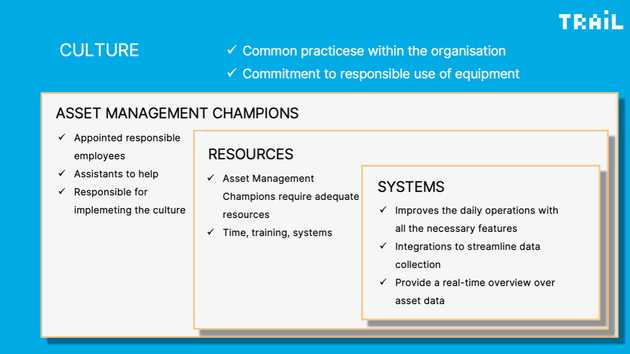The 4 cornerstones of successful asset management - How to avoid unpleasant surprises
Contrary to popular belief, managing machinery, equipment, and other assets is not a waste of time or a necessary evil. In fact, successful companies turn sustainable asset management into a financial tool that brings significant benefits to financial planning.
Interested in learning how you can implement better asset management practices in your organisation? Contact us
At Trail, we have been solving asset and equipment management challenges with our customers for over a decade. In this blog post, I will delve into the reasons and consequences of poor asset management, as well as the four cornerstones that any organisation can use to turn sustainable asset management into a competitive advantage.
What causes the lack of control?
In essence, inadequate asset management stems from the lack of information. You cannot manage what you don't know.
You, most definitely, have information about acquired and owned assets but this information is almost always fragmented. It is found in various systems and even in employees' Excel sheets and sticky notes. However, an up-to-date overview is nowhere to be found.
The lack of information and fragmentation, in turn, stems from the lack of culture. In few organisations, sustainable procurement or use of equipment is encouraged. Consequently, employees treat equipment as disposable, and do not care about tracking it or maximising its lifecycle.
In a world of dwindling resources, the lack of asset management is highly irresponsible. The lack of an overview and culture leads to unnecessary purchases, wasting natural resources and budgets.
Avoid unpleasant surprises with sustainable asset management
In simple terms, poor asset management leads to unnecessary costs and waste of time. From a financial perspective, the lack of comprehensive information also leads to unpleasant surprises: when a complete overview over all assets and equipment is missing, the risk of unforeseen and urgent purchases increases.
These surprises are costly. For example, tools reaching the end of their lifecycle may require quick replacement, costing hundreds of thousands of euros for larger companies. If information about these is not available in advance, quick and expensive actions are needed.
Additionally, problems tend to escalate when left unattended. The longer information about assets is scattered, the more equipment is lost, and the more time and money are spent on resolving the situation.
Beware of a false sense of security
Many readers may now be thinking, "the situation in our organisation is completely under control because we use multiple systems for this." In the best-case, this is true.
Unfortunately, this is often a false sense of security. Especially in larger organisations, there is a vast amount of unknown equipment. This leads easily to purchasing of equipment you already have or surprises regarding their need for replacement.
Rarely, all equipment information is in one place and available to everyone. Systems are only available for a few key people, thus preventing other employees to see what equipment the organisation has. In addition, none of the available systems collects the information from all sources: e.g. other systems and from employees’ notes and Excel-sheets.
Therefore, it is advisable to carefully assess the current situation and ensure that the information remains up-to-date. This way, you move from guessing to knowing.
Take the survey: What is the state of your company's asset management
The 4 cornerstones of sustainable asset management
Let's now explore the four cornerstones of sustainable asset management mentioned in the title. With these, you ensure that you create and maintain complete and up-to-date equipment information to support financial planning and decision-making:
- Culture of sustainable asset management
- Assigned responsible employees
- Adequate resources
- Versatile asset management system
Build a culture of sustainable asset management
Sustainable asset management cannot rely only on a few individuals within the organisation. It requires the commitment of the entire organisation, which depends on the right culture.
There must be common rules that the entire organisation follows. Common practices should encourage every employee to take responsibility for the organisation's equipment. These practices could include, for example:
- Investigating existing equipment before making a purchase decision
- Sharing equipment across departments to increase usage rate and avoid unnecessary purchases
- Registering and tagging purchases upon arrival
- Ensuring proper maintenance and service of the equipment
However, cultural change takes time and effort. Nevertheless, it is a worthwhile investment because without a cultural change, a permanent change will not happen.
Assign responsible employees
Although sustainable asset management is the responsibility of the entire organisation, there must be individuals who are responsible for the whole. A so-called Asset Management Champion. One person is rarely enough, so it is recommended to appoint several responsible individuals. Or at least one responsible person and assistants for them.
Asset Management Champion’s responsibility is not to conduct continuous inventory throughout the organisation but to ensure the implementation of sustainable asset management culture. Their task is to create processes and procedures and to train the rest of the organisation.
Naturally, these individuals should also have ultimate responsibility for the equipment. In large organisations, this means that they must also have the authority to create, disseminate, and monitor culture throughout the organisation.
Provide resources
Asset Management Champions and the rest of the organisation must have adequate resources to manage equipment sustainably. Nothing happens if equipment management is assigned to someone without any real possibility to utilise work time for it.
Especially the Asset Management Champions need time. They do not have to allocate 100% of their work time for equipment management, but especially in larger companies, this is desirable. When the costs of lax equipment management amount to hundreds of thousands or millions of euros annually, hiring a few people to solve the problem is a very moderate cost.
In addition to time, suitable training should be provided to staff. At the very least, responsible individuals should be trained to create the processes mentioned earlier. They are also supposed to train other staff as part of creating and maintaining a culture of sustainable asset management.
Implement the suitable asset management system
As mentioned earlier, the lack of management results from the lack of information. To make information available, you need a system that can collect, process, share, and enrich that information.
Hence, in addition to time, authority, and training, the most important resource is a functional asset management system. It ensures that information is available to everyone, and supports decision-making.
The system should include all the essential functions for sustainable asset management so that it is used as part of operational activities. The reason is that employees use fragmented Excel-sheets, post-it notes, and random papers to manage these if a better system is not available.
These functionalities should include at least:
- Open equipment register
- Individual RFID, NFC, or QR code tags
- Equipment reservations
- Maintenance and defect reports
- Inventories
- Investment planning
When these functionalities are available, employees can replace those fragmented Excel lists, notebooks, and post-it notes with a functioning system.
Read more: Comparing digital asset registers
Integration possibilities of the system should be considered. To collect all data, the asset management system must be able to retrieve information from other systems where information about the equipment already exists.
A comprehensive asset management system is therefore essential for gathering and maintaining complete equipment information.
Summary
The risks of inadequate and fragmented asset management are costly. Without reliable information about all equipment, an organisation makes unnecessary purchases and faces expensive unforeseen investment needs.
Sustainable asset management is the responsibility of the entire organisation, requiring a cultural change. It is worth appointing responsible individuals to drive this change, providing them with adequate resources. The most important resources in use are a versatile asset management system that provides functional tools to replace fragmented notebooks and create a complete picture by gathering data from other systems.
If you are interested in discussing in more detail how to start creating these cornerstones in your organisation, contact us! Let's discuss your needs more closely in a meeting.

